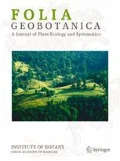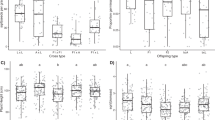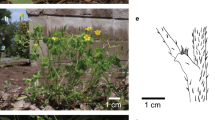Abstract
Hybridization in annual plants is rare, but their short life cycle provides an excellent opportunity to study the dynamics of hybridization. Hybridization occurs between the annual hemiparasites Rhinanthus minor and Rhinanthus angustifolius (Orobanchaceae). Using flower morphology, Kwak (1980) found a prevalence of hybrids close to R. angustifolius in a single population. We aim to find whether this pattern is also found using genetic markers, whether it is generally occurring in mixed populations, and whether these populations are stable over time. We used species-specific genetic markers to determine the number of individuals in a range of hybrid classes in three mixed populations of different ages during four consecutive years. In the young population, F1 hybrids were found in the first year and mostly hybrids between R. minor and these F1s in the second year, but in the years after that, hybrids close to R. angustifolius became more abundant. We also found this in the two older populations, where hybrids close to R. angustifolius always occurred in higher frequencies than hybrids close to R. minor. Over time, R. angustifolius strongly increased in frequency in two populations. Patterns of marker presence and absence suggested that advanced-generation hybrids are mainly formed by backcrossing with one of the parents, predominantly R. angustifolius whenever its frequency in the population is higher than 15%. The dynamics of mixed populations depend on the ecological conditions that regulate the presence of the two parental species, and introgression into R. angustifolius seems prevalent.




Similar content being viewed by others
References
Ameloot E, Verheyen K, Bakker JP, de Vries Y, Hermy M (2006) Long-term dynamics of the hemiparasite Rhinanthus angustifolius and its relationship with vegetation structure. J Veg Sci 17:637–646
Anderson E (1949) Introgressive hybridization. John Wiley and Sons, New York
Arnold ML (1993) Iris nelsonii (Iridaceae): origin and genetic composition of a homoploid hybrid species. Amer J Bot 80:577–583
Arnold ML (1997) Natural hybridization and evolution. Oxford University Press, New York
Bakker JP (2006) Vegetation conservation, management and restoration. In van der Maarel E (ed) Vegetation ecology. Blackwell Publishing, Oxford, pp 309–331
Barton NH, Hewitt GM (1985) Analysis of hybrid zones. Annual Rev Ecol Syst 16:113–148
Britch SC, Cain ML, Howard DJ (2001) Spatio-temporal dynamics of the Allonemobius fasciatus-A. socius mosaic hybrid zone: a 14-year perspective. Molec Ecol 10:627–638
Buerkle CA (2005) Maximum-likelihood estimation of a hybrid index based on molecular markers. Molec Ecol Notes 5:684–687
Burgess KS, Morgan M, Deverno L, Husband BC (2005) Asymmetrical introgression between two Morus species (M. alba, M. rubra) that differ in abundance. Molec Ecol 14:3471–3483
Burke JM, Voss TJ, Arnold ML (1998) Genetic interactions and natural selection in Louisiana iris hybrids. Evolution 52:1304–1310
Campion-Bourget F (1980a) L’autogamie et l’allogamie chez les cinq principales espèces de Rhinanthus L. de France. Rev Cytol Biol Veg Bot 3:199–219
Campion-Bourget F (1980b) L’hybridation interspécifique expérimentale chez les cinq principales espèces de Rhinanthus L. de France. Rev Cytol Biol Veg Bot 3:221–280
Carney SE, Gardner KA, Rieseberg LH (2000) Evolutionary changes over the fifty-year history of a hybrid population of sunflowers (Helianthus). Evolution 54:462–474
Cattell MV, Karl SA (2004) Genetics and morphology in a Borrichia frutescens and B. arborescens (Asteraceae) hybrid zone. Amer J Bot 91:1757–1766
Cruzan MB, Arnold ML (1993) Ecological and genetic associations in an Iris hybrid zone. Evolution 47:1432–1445
de Hullu E, Brouwer T, ter Borg SJ (1985) Analysis of the demography of Rhinanthus angustifolius populations. Acta Bot Neerl 34:5–22
Demesure B, Sodzi N, Petit RJ (1995) A set of universal primers for amplification of polymorphic non-coding regions of mitochondrial and chloroplast DNA in plants. Molec Ecol 4:129
Doyle JJ, Doyle JL (1990) Isolation of plant DNA from fresh tissue. Focus 12:13–15
Ducarme V (2008) Ecologial and genetic aspects of natural hybridization in Rhinanthus L. PhD thesis, Louvain University, Louvain-la-Neuve
Ducarme V, Wesselingh RA (2005) Detecting hybridization in mixed populations of Rhinanthus minor and Rhinanthus angustifolius. Folia Geobot 40:151–161
Ducarme V, Wesselingh RA (2010) Performance of two Rhinanthus species under different hydric conditions. Pl Ecol 206:263–277
Dumolin-Lapègue S, Pemonge M-H, Petit RJ (1997) An enlarged set of consensus primers for the study of organelle DNA in plants. Molec Ecol 6:393–397
Erazzu LE, Camadro EL, Clausen AM (2009) Persistence over time, overlapping distribution and molecular indications of interspecific hybridization in wild potato populations of Northwest Argentina. Euphytica 168:249–262
Ervin GN, Wetzel RG (2002) Influence of a dominant macrophyte, Juncus effusus, on wetland plant species richness, diversity, and community composition. Oecologia 130:626–636
Fritz RS, Nichols-Orians CM, Brunsfeld SJ (1994) Interspecific hybridization of plants and resistance to herbivores – hypotheses, genetics, and variable responses in a diverse herbivore community. Oecologia 97:106–117
Harrison RG (1990) Hybrid zones: windows on evolutionary process. In Futuyma D, Antonovics J (eds) Oxford Surveys in Evolutionary Biology 7. Oxford University Press, Oxford, pp 69–128
Harrison RG (1993) Hybrids and hybrid zones: historical perspective. In Harrison RG (ed) Hybrid zones and the evolutionary process. Oxford University Press, New York, pp 3–12
Huang SSF, Hwang SY, Lin TP (2002) Spatial pattern of chloroplast DNA variation of Cuclobalanopsis glauca in Taiwan and East Asia. Molec Ecol 11:2349–2358
Johnston JA, Wesselingh RA, Bouck AC, Donovan LA, Arnold ML (2001) Intimately linked or hardly speaking? The relationship between genotype and environmental gradients in a Louisiana Iris hybrid population. Molec Ecol 10:673–681
Kelly D (1989) Demography of short-lived plants in chalk grassland. 3. Population stability. J Ecol 77:785–798
Knobloch IW (1972) Intergeneric hybridization in flowering plants. Taxon 21:97–103
Kwak MM (1978) Pollination, hybridization and ethological isolation of Rhinanthus minor and R. serotinus (Rhinanthoideae: Scrophulariaceae) by bumblebees (Bombus Latr.). Taxon 27:145–158
Kwak MM (1979a) Effects of bumblebee visits on the seed set of Pedicularis, Rhinanthus and Melampyrum (Scrophulariaceae) in the Netherlands. Acta Bot Neerl 28:177–195
Kwak MM (1979b) Maintenance of species integrity in sympatrically occurring Rhinanthus minor and Rhinanthus serotinus in the Netherlands. Oecologia 41:1–9
Kwak MM (1980) Artificial and natural hybridization and introgression in Rhinanthus (Scrophulariaceae) in relation to bumblebee pollination. Taxon 29:613–628
Kwak MM, Holthuijzen YA, Prins HHT (1985) A comparison of nectar characteristics of the bumblebee-pollinated Rhinanthus minor and Rhinanthus serotinus. Oikos 44:123–126
Lambinon J, Delvosalle L, Duvignaud J (2004) Nouvelle flore de la Belgique, du Grand-Duché de Luxembourg, du Nord de la France et des régions voisines, Ed. 5 National Botanic Garden of Belgium, Meise
Lepais O, Petit RJ, Guichoux E, Lavabre JE, Alberto F, Kremer A, Gerber S (2009) Species relative abundance and direction of introgression in oaks. Molec Ecol 18:2228–2242
Minder AM, Rothenbuehler C, Widmer A (2007) Genetic structure of hybrid zones between Silene latifolia and Silene dioica (Caryophyllaceae): evidence for introgressive hybridization. Molec Ecol 16:2504–2516
Nason JD, Ellstrand NC, Arnold ML (1992) Patterns of hybridization and introgression in populations of oaks, manzanitas, and irises. Amer J Bot 79:101–111
Pellegrino G, Bellusci F, Musacchio A (2009) Genetic integrity of sympatric hybridising plant species: the case of Orchis italica and O. anthropophora. Pl Biol 11:434–441
Perron M, Bousquet J (1997) Natural hybridization between black spruce and red spruce. Molec Ecol 6:725–734
Perron M, Gordon AG, Bousquet J (1995) Species-specific RAPD fingerprints for the closely-related Picea mariana and P. rubens. Theor Appl Genet 91:142–149
Rameau JC, Mansion D, Dumé G (1989) Flore forestière française, guide écologique illustré. Vol. 1 Plaines et collines. Institut pour le Développement Forestier, Paris
Repplinger M, Johannesen J, Seitz A, Comes HP (2007) Morphological and molecular evidence for hybridization and introgression in Central European Arctium (Asteraceae). Pl Syst Evol 268:75–95
Rhymer JM, Simberloff D (1996) Extinction by hybridization and introgression. Annual Rev Ecol Syst 27:83–109
Rieseberg LH (1991) Homoploid reticulate evolution in Helianthus (Asteraceae): evidence from ribosomal genes. Amer J Bot 78:1218–1237
Rieseberg LH (1995) The role of hybridization in evolution – old wine in new skins. Amer J Bot 82:944–953
Rieseberg LH, Brunsfeld SJ (1992) Molecular evidence and plant introgression. In Soltis PS, Soltis DE, Doyle JJ (eds) Molecular systematics of plants. Chapman & Hall, New York, pp 151–176
Rieseberg LH, Wendel JF (1993) Introgression and its consequences in plants. In Harrison RG (ed) Hybrid zones and the evolutionary process. Oxford University Press, New York
Sang T, Crawford DJ, Stuessy TF (1997) Chloroplast DNA phylogeny, reticulate evolution, and biogeography of Paeonia (Paeoniaceae). Amer J Bot 84:1120–1136
Siegel S, Castellan NJ, Jr (1988) Nonparametric statistics for the behavioral sciences, Ed. 2. McGraw-Hill, New York
Sokal RR, Rohlf FJ (1995) Biometry, Ed. 3. Freeman, New York
Taberlet P, Gielly L, Pautou G, Bouvet J (1991) Universal primers for amplification of three non-coding regions of chloroplast DNA. Pl Molec Biol 17:1105–1109
van der Meijden R (1990) Heukels’ Flora van Nederland, Ed. 21. Wolters-Noordhoff, Groningen
Van Landuyt W (1993) De Kalkense Meersen. Nieuwsbrief werkgroep Kalkense Meersen 1993:10–20
Van Landuyt W, Hoste I, Vanhecke L, Van den Bremt P, Vercruysse W, De Beer D (2006) Atlas van de Flora van Vlaanderen en het Brussels Gewest. Instituut voor natuur- en bosonderzoek, Nationale Plantentuin van België & Flo.Wer, Brussel
Vrancken J (2010) Individual and comparative phylogeography of Rhinanthus angustifolius and Rhinanthus minor in Europe. PhD thesis, Louvain University, Louvain-la-Neuve
Vrancken J, Brochmann C, Wesselingh RA (2009) How did an annual plant react to Pleistocene glaciations? Postglacial history of Rhinanthus angustifolius in Europe. Biol J Linn Soc 98:1–13
Watkinson AR, Gibson CC (1988) Plant parasitism: the population dynamics of parasitic plants and their effect upon plant community structure. In Davy AJ, Hutchings MJ, Watkinson AR (eds) Plant population ecology, The British Ecological Society. Blackwell, Oxford, pp 393–411
Weeda EJ (1988) Ratelaar/Rhinanthus. In Weeda EJ, Westra R, Westra C, Westra T (eds) Nederlandse oecologische flora: wilde planten en hun relaties 3. IVN, Amsterdam, pp 234–237
Westbury DB (2004) Biological Flora of the British Isles: Rhinanthus minor L. J Ecol 92:906–927
Acknowledgements
We thank Linda Dhondt and Christine Noël for their technical assistance in the laboratory, the site managers Jean Vermander of the experimental garden Jardin Massart, Martin Swannet of Kijkverdriet and Kristin Van de Velde of Kalkense Meersen for permission to sample and the Belgian National Fund for Research (FRFC 2.4573.02) and the Fonds Spéciaux de Recherche of Louvain University for financial support. Anonymous reviewers gave useful comments on earlier versions of the manuscript. The floristic data we used to identify possible hybrid populations in Flanders came from the Florabank (permission 2000-wvl-8), provided by Flo.Wer. This is contribution nr. BRC161 of the Biodiversity Research Centre of Louvain University.
Author information
Authors and Affiliations
Corresponding author
Rights and permissions
About this article
Cite this article
Ducarme, V., Vrancken, J. & Wesselingh, R.A. Hybridization in Annual Plants: Patterns and DynamicsDuring a Four-Year Study in Mixed Rhinanthus Populations. Folia Geobot 45, 387–405 (2010). https://doi.org/10.1007/s12224-010-9077-2
Received:
Revised:
Accepted:
Published:
Issue Date:
DOI: https://doi.org/10.1007/s12224-010-9077-2




